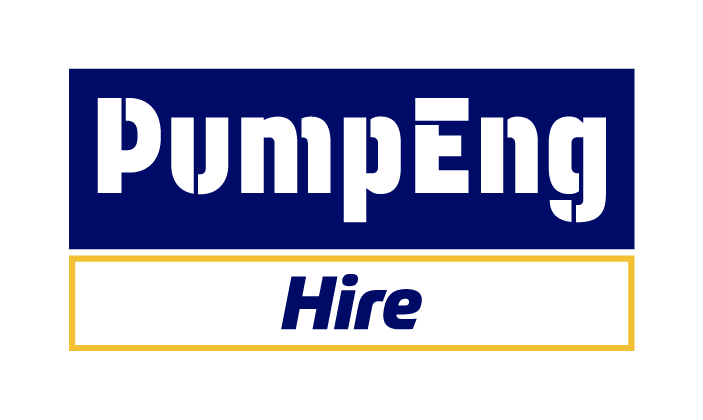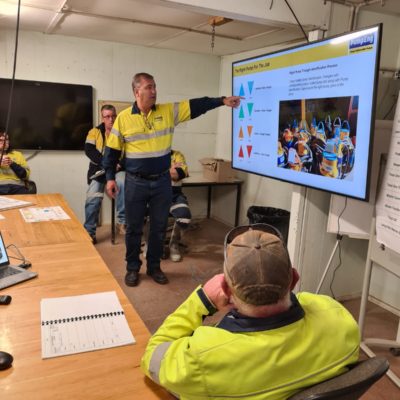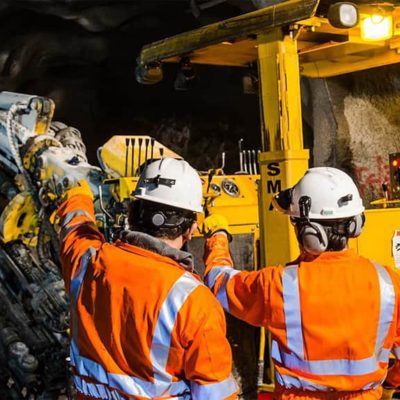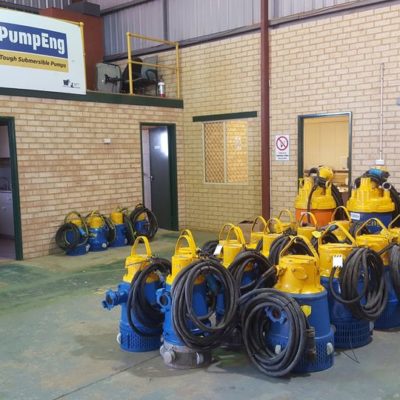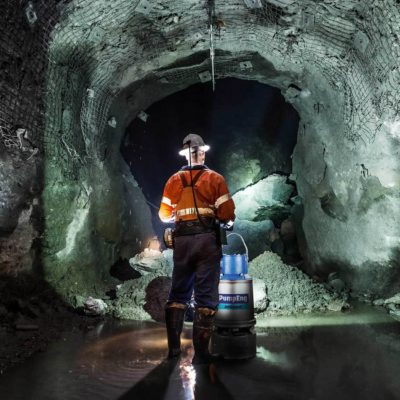Hiring PumpEng pumps can be a low cost way to explore solutions based on continuous improvement methodologies for dewatering underground mines. By procuring pumps within a hire agreement, rather than through purchase or lease arrangements, mine managers can test new-generation dewatering pumps and continuous improvement strategies faster with less cost and risk. This lower-risk strategy allows managers to dramatically improve the pump performance of the worst pumps in the worst sumps.
When mine dewatering pumps break down, the direct impacts include:
- Loss of production
- Delays in production
- Maintenance crew diversion
- Increased safety risk
These break down consequences affect the mine operation on a number of levels:
- Mine managers have to embed downtime in mine plans and production targets
- Maintenance managers have to divert crews from productive or preventative work
- Crews are at risk through moving heavy equipment in high-risk underground environments with water and electricity present
Financial impacts include capital cost of frequent pump replacements and expensive repairs, loss of production earnings and excess wages for maintenance personnel and unnecessary logistics.
For several decades, the underground mining sector has traditionally used the same dewatering pump models and stock management approaches, such as leasing programs. The downside of the current model is represented in cost blowouts for repair and replacement of leased and purchased pumps and wasted human resources through constant pump maintenance events. The most significant impact, representing the highest risk, is the potential for frustrating and expensive delays to production caused by pump failure.
Fixing The Worst Pumps and the Worst Sumps
In any fleet of mine dewatering pumps, it is likely that the worst pumps and the worst sumps account for the majority of problems. By identifying the worst pumps and sumps, assessing the root cause of the problems, and applying the right pumps in the right places, significant benefits can be realised including:
- Improving continuous production periods
- Freeing resources for other jobs
- Increasing dewatering pump operational life
- Reducing the cost of repairs and replacement
- Reducing materials used for pump repairs and replacements
- Improving crew morale by reducing maintenance events
- Reducing the exposure of crews to hazardous workplaces
What Dewatering Pumps Need to Deal With
Modern mining environments are very hard on dewatering pumps because the materials contained in the wastewater clog or damage pump components. These materials include;
- Shotcrete poly fibre
- Tramp/Trash
- Dirty water
- Drill fines
- Slurry
New generation pumps have improved design that protects the pump from much of this damage. Properly applied, these dewatering pumps can significantly reduce pump turnaround as well as lower replacement, repair and maintenance costs.
A Data-Driven Approach to Pump Replacement
New disruptive pump technologies combined with a data-driven dewatering methodology are dramatically improving pump performance standards and the overall efficiency of underground dewatering management. This change in dewatering strategy is leading to a significant positive impact on costs and use of human resources within the mining sector.
Some barriers to deploying new generation pump technologies to address these issues can include the high costs involved with purchasing or leasing pump fleets.
Purchasing pumps outright can deliver the best long-term solution for a well-specified fleet of dewatering pumps. While leasing can provide cash flow benefits, it typically results in a higher total cost of ownership once finance costs and fixed terms are taken into account.
For both purchasing and leasing strategies, the total cost of ownership assessment should factor in the effective life of the pump and the costs of repairs and maintenance during its life.
Hiring dewatering pumps is not the lowest cost solution for a mature fleet of pumps, however, it is a very cost-effective option for the testing of new technologies. By utilising hire agreements, short-term trials of pump performance in the actual mine can identify significant financial and operational benefits to be realised over the medium to longer term.
Hire can also provide short-term expansion of the pump fleet. For example, in some regions the wet season will dramatically increase the number of pumps required for dewatering. Hire gives mine operators the flexibility needed to respond to season or unseasonal fluctuations in dewatering requirements.
Procurement Method Comparison for Mine Dewatering Pumps
| Purchase | Lease | Hire | |
|---|---|---|---|
| Costs | High Upfront Cost | Lower Upfront Cost Complex Financial Terms | Fixed Monthly Fee |
| Term | One Off | Fixed Term | Flexible Term |
| Replacement Costs of Pump Failure | Full | Full | Nil |
| Fair Wear & Tear | Owner Incurred | Lessee Incurred | Vendor Incurred |
| Preventative Maintenance Costs | Full | Full | Nil |
| Damage Caused by Misuse | Owner | Lessee | Owner |
| Replacement Availability | Subject to Stock Availability | Subject to Stock Availability | Vendor Managed Hire Pool |
| Site Assessment & Installation | Owner | Lessee | Vendor or Owner |
| Data Collection & Analysis | Owner | Lessee | Hire Vendor (shared with Owner) |
| Operational Life Expectancy | Owner Managed | Lessee Managed | 180 days |
| Short-term Requirements | N/A | N/A | Short-term Hire |
Using the hire approach to procuring new generation pumps is allowing mining operators high speed and low risk access to these technologies. Mine managers can test the in-situ performance of pumps using obligation free hire agreements that can potentially lead to significant improvements in the efficiency of their operation as well as their bottom line.
Currently, mine operators are facing the choice of expensive upfront pump purchase or lower upfront leasing with the hidden cost of pump replacement when the pumps are damaged through incorrect use.
By hiring to test solutions for the worst pumps and the worst sumps, mine operators can benefit from having fair wear and tear included in the daily hire rate for the pump, reducing maintenance costs. Pumps that are returned for repair assist both operator and supplier in identifying the likely root cause for return. An inspection of the pump and a review of the data can provide feedback to the mine site on what improvements are needed. This continuous improvement partnership delivers an opportunity to work together to achieve less production delay and a happier working environment with less frustration and waste.
3.1 Post Failure Inspection of Pump Damage
Each hire pump that is returned is carefully assessed to learn more about what is happening at different dewatering sites within a mine.
Through a process of constant improvement, the dewatering system within the mine is refined with the purpose of extending the life of every pump used within the overall dewatering management system.
3.2 A Continuous Improvement Approach for Dewatering Pumps
In summary, continuous improvement in dewatering pump management is achieved through key initiatives:
- Assessment: data and specification drive approach to select the right pump for the job
- Acquisition: use of purchase, leasing and hire approaches to best fit the requirement at hand
- Operational Assessment: use a data-driven approach to improve pumps in operation
- Post Failure Inspection: inspection of pumps after failure and root cause analysis.
4.1 Innovation From PumpEng
PumpEng, are leading this major change in dewatering by introducing new levels of professionalism to the management of dewatering in underground mines. The PumpEng Way is an approach where mine operators benefit from hiring a carefully monitored set of dewatering pumps that deliver next generation technology improvements and a more reliable dewatering system.
The switch to hiring pumps provides operators with an opportunity to study new standards of pump performance onsite in their toughest underground environments. Mine managers have an opportunity to learn about The PumpEng Way methodology without having to make significant capital investment through the purchase of pumps or expose themselves to cost blowouts through low upfront cost lease/high cost of replacement schemes. This approach can transform how pumps are used, reduce the costs of maintenance and repairs and free up crews for more productive work by reducing the number of pump failures. Hire provides a better fixed/capped rate for better cost control. Malicious damage is not hidden, it is identified. This allows for process improvement onsite that results in better trained personnel and longer pump life.
4.2 Continuous Improvement Approach - The PumpEng Way
4.2.1 Explore Options - Obligation Free
The PumpEng Way is a very different approach to dewatering. We don't just sell or hire a pump and walk away. Instead, we regard every mine operation as a partner. There is a company-wide commitment to constant improvement and problem-solving.
4.2.2 Site Inspection - Build Insight into Your Needs For Current and Future Developments
Every underground mine is going to have a number of dewatering sites. These will differ in challenges, such as water quality, depth and water volume. Experienced PumpEng engineers will inspect the mine to learn about each of these sites. They will listen to the operators on the ground to better understand what is affecting the smooth running of that part of the dewatering operation.
4.2.3 Present Solutions - Devise Data-driven Solutions for Reliable Dewatering Pumps
Once PumpEng has identified which dewatering strategy is most suitable in each circumstance, that system will be implemented. Any pumps returned will be studied to determine the point of failure and adjust the approach for that site accordingly. This might be the selection of a different pump or an adjustment to pump operation.
4.2.4 Continuous Improvement - Quarterly Data Analysis & System Improvement - A Partnership
PumpEng is committed to working closely with mine sites to constantly improve how their dewatering system operates. Quarterly reviews of the site will evaluate and improve the performance of that dewatering system.
4.2.5 The Challenge of Correct Pump Placement
Dewatering systems must work in a flexible, fast-paced, sometimes chaotic underground environment where personnel have varying experience in choosing and installing dewatering pumps. The pressure to solve problems fast can mean these inexperienced people may install pumps that are unsuitable for their operating conditions. For mine operators, incorrect pump selection has several knock-on effects, including expensive pump repairs and replacement, frustrating production delays and having to send maintenance crews into environments where water and electricity increase workplace risk.
4.2.6 Onsite Inspections To Determine The Right Pump for the Job
The PumpEng Way refines pump selection. The right pump for the job is identified by a PumpEng Applications Engineer during their assessment of the site. PumpEng then uses a colour-coded pump identification system to ensure the appropriate pump is chosen, even by the most inexperienced team member working under pressure.
4.3 Pumps Designed For Modern Underground Mining
Modern-generation dewatering pumps are specifically designed for the underground environment where Shotcrete poly fibre may be present in the wastewater. PumpEng submersible pumps are designed for this environment. For a fixed daily high rate, PumpEng is willing to put its pump assets into underground mining environments. If used correctly, PumpEng maintains that mine managers will see a dramatic increase in the life of dewatering pumps. The PumpEng goal is to get every asset working for 180 days before it comes back for repair. Achieving that will have many positive flow-on benefits across the whole mining operation, including production targets, reducing expenses and improved team safety and morale.
4.4 Case Study
A mine site operator hired a fleet of ten PumpEng pumps. Four pumps were returned in under 90 days with electrical overload protection issues. Electrical overload occurs when maintenance crews take a bigger pump out and put a smaller pump in, and the smaller pump is now not electrically protected. PumpEng identified the improvement required and created an education program for the maintenance crew. After the electrical overload issue was resolved, the fleet of 10 hire pumps was returned 1.2 times per year, on average.
4.5. Business Case Based On Critical Information
PumpEng has systems for capturing pump performance data. Our hire terms and conditions cover the cost of hire pump maintenance. We are invested in data analysis and the process of constant improvement.
PumpEng can isolate the areas of improvement and reduce pump failure. These achievements are all about ensuring the correct application of the pump. Correct application is important because the right pump for the job will see a dramatic reduction in pump failure.
The benefit for PumpEng is that, if we can achieve longer pump life, there is less risk for both businesses. By working with mine operators and identifying the cause of damage, improvements can be identified.
From a cost benefit perspective, mine operators benefit from the stability of fixed monthly costs for a flexible period of engagement.
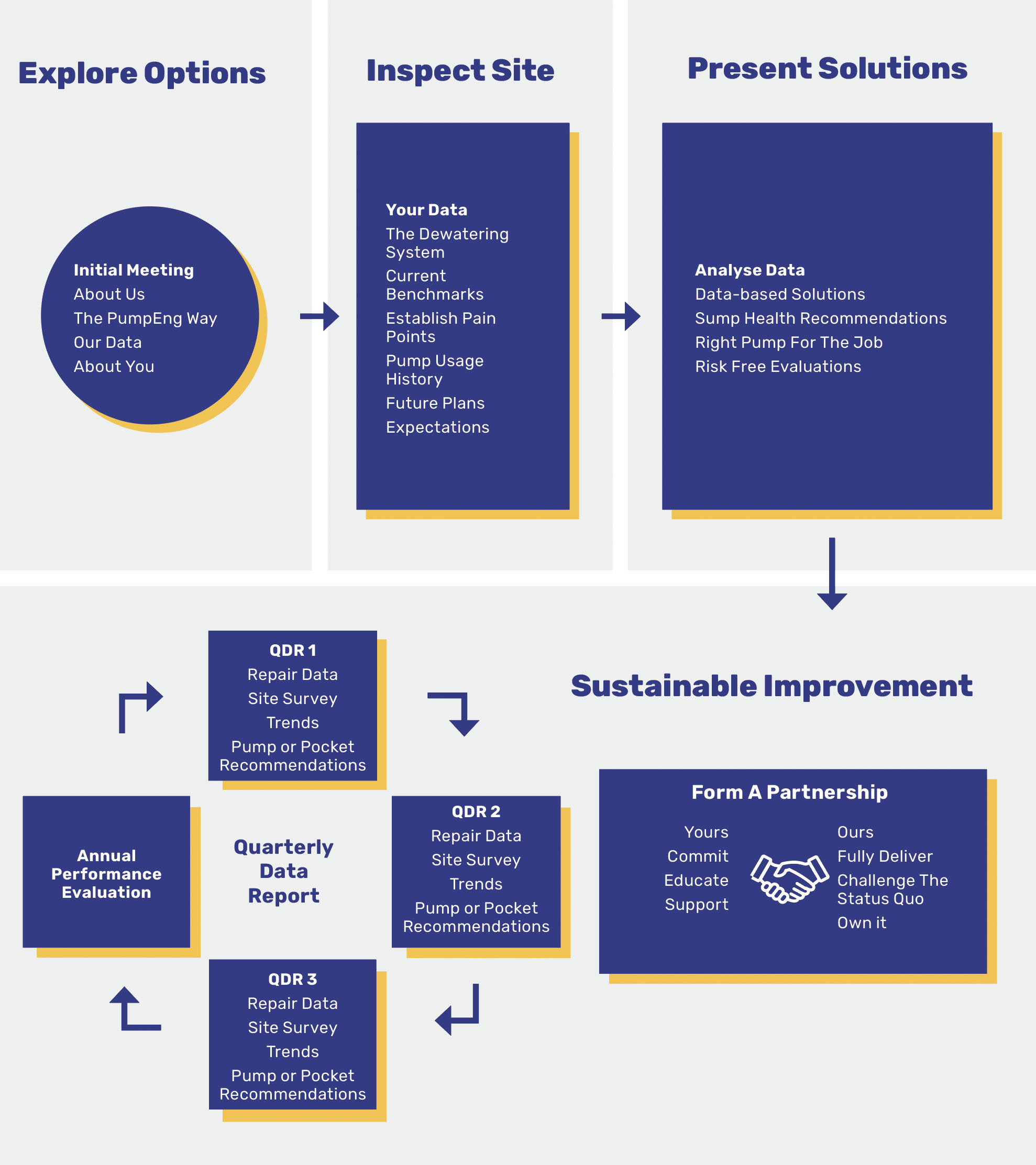
The PumpEng Way combined with PumpEng Hire provides a low-risk opportunity to increase pump performance and reduce delays in production dramatically. Here is how one Project Supervisor described pump performance improvements at his site.
“In a typical week with our last supplier, we’d be sending off two or three pumps per week for maintenance. These days, we’d be lucky to send out two or three in a whole month. That, in itself, speaks volumes.”
Project Supervisor, WA Underground Gold Mine
This new generation approach to dewatering management provides mine operators with an opportunity to implement a highly reliable dewatering system, likely to give everyone on a site a good day at work.
Submersible Dewatering Pumps for Hire
How To Hire Pumps
Simply call us on
(08) 9434 9922 for Australia
1 (208) 749-7636 for US
or fill out the enquiry form below.
We will provide you with a comprehensive quote and confirm availability.
Pump Hire Enquiry Form
